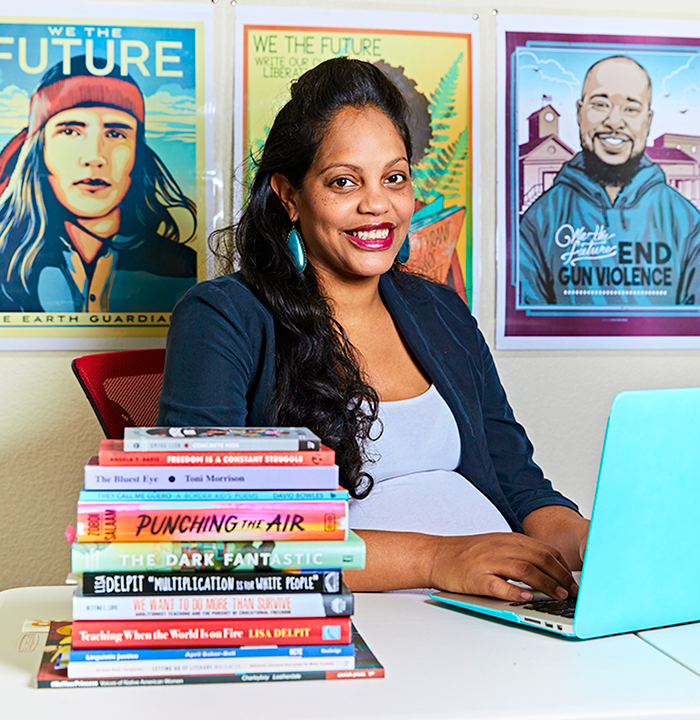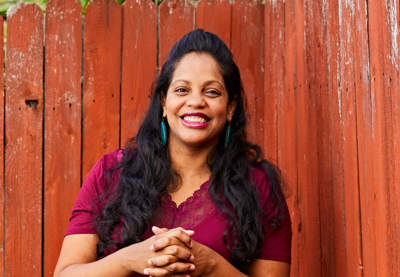Lorena Germán has worked in education for nearly 20 years. As director of pedagogy at EduColor, chair of the National Council of Teachers of English Committee Against Racism and Bias in the Teaching of English and co-founder of Multicultural Classroom, she has advocated for culturally sustaining pedagogy and practices. Nearly three years ago, Germán joined together with educators Tricia Ebarvia, Dr. Kim Parker and Julia E. Torres to form #DisruptTexts, a grassroots movement encouraging K-12 English teachers to rethink their approach to teaching the “classics,” including deciding whether they need to teach them at all. In 2019, she published The Anti Racist Teacher: Reading Instruction Workbook, a resource to help educators develop anti-racist practices in their ELA classes. And late last year, Germán sat down with then-TT Professional Development Manager Val Brown to discuss the damage white supremacy causes in education—and the uplift inherent in reimagining the process. Their conversation, included here, has been edited for length and clarity.
“Interrupting white supremacy,” “decolonizing education,” “developing abolitionist education”—people use these phrases but aren’t always sure what they mean. How would you define these terms as they relate to your practice?
White supremacy literally means that whiteness is supreme over others. We see that present in our values as a nation, in our culture, in our ways of being and, therefore, embedded in all of our systems.
When a lot of people think of white supremacy, they connote white men in hoods on corners screaming racial slurs and doing extreme things, but white supremacy could be used interchangeably for racism.
What’s important is that we don’t get caught up on these terms because it’s less about the words and much more about the approach, the philosophy and the theory.
It’s the belief system used to bring racism into action. There are many other terms in education, too, like “equity,” that are unclear to people. They do have their own definitions, but they are all related and they do depend on each other.
What’s important is that we don’t get caught up on these terms because it’s less about the words and much more about the approach, the philosophy and the theory. That’s why I use “culturally sustaining.” I find that it’s the most inclusive. Culturally sustaining tells you what I’m for—to nurture and build.
How did white supremacy show up for you as a student?
I grew up in a town where most of my classmates were, like me, brown children, but most [teachers]—and probably all, up until high school—were white women.
Is it bad to have a white woman teacher? No. Is it bad to have all white women teachers over x many years? Yes. Because there’s so much that happened in terms of how I perceived education to be, how I functioned in the classroom and the tangible cultural gaps that I experienced.
The memories I have, unfortunately, are overwhelmingly negative. I didn’t ever have powerful teachers of color in my field, English, until graduate school, which is where I met Dr. Django Paris and his wife, Rae Paris, who were both amazing educators. I also met Dr. David Kirkland and Dr. Adam Banks: I ended up getting flooded. It was a wonderful over-compensation for everything that I went through. But if education was not something that in my home meant everything, I wouldn’t have made it there. Why would I go to graduate school after the types of experiences I had?
Being an immigrant, particularly from our Black and brown country, one interesting aspect of that experience is that we come here and while we’re taxi drivers, or we’re somebody’s cleaning lady or we’re a barber, in Dominican Republic, actually, that person is an engineer; that other person is actually a lawyer. In the same way, I would think about how my grandfather was a science teacher in the U.S., but he’s an engineer in Dominican Republic. Oh, my grandmother is a seamstress, but over there she was at the Department of Education. I was always very aware of that duality. I had a consciousness of, “Yeah, we might be whatever this experience is here in the U.S., but I also know that I have a whole nation of people.” It was always very much like, “This might be my reality, but this ain’t the truth.”
You turned much of your experience as a student and graduate student into a resource for educators, The Anti Racist Teacher: Reading Instruction Workbook. Can you talk about that?
So I graduated college and I’m like, “Me? Teacher? No. I will never go work in classrooms.” But I have always been drawn to working with young people, and eventually I made my way back into the classroom. I went back to the very high school that I had gone to because, clearly, I had some things to resolve. I was like, “OK, fine. I guess I’m back.” It was so much. As I was there, I was like, “OK, the way I’m going to stay sane here is to remember what I’m doing, that I am here to be the teacher that I never had.” It all really started then: having to re-envision, to reconsider, to rethink what teaching meant and looked like. The workbook comes out of all of those years of trying to figure that out and wanting to be practical.

What do you see that needs changing? How do you see white supremacy showing up in curriculum and instruction today?
It looks like this overwhelming sense of urgency to meet particular deadlines that don’t necessarily speak to actual student growth. It’s like, “Well, we have to cover this book because that’s what’s on the test and we have more, more, more.” It’s about quantity over quality. I think it’s really hard for English teachers to consider, “Oh, we will just read two books this year.” If an English teacher said that, somebody somewhere would faint. That would be dope, that the whole first semester you go so deep into a rich book and you [work just] with that book. Young people learn it, and you use it to not just read the word but read the world.
This value for individualism, this idea of “you pull yourself up by the bootstraps”—we see that in classrooms, that you do the work all by yourself, you got the A and you’re at the top of your class. Instead of, “Look, this group took on this work together, and everyone explored their strengths, improved in their areas of growth and there was learning that was both curricular and extracurricular.” That’s the real world; that’s professional life, and we don’t necessarily value that in classrooms. It requires stepping back, being honest and reevaluating a lot of the things that we’ve taken as orthodox practices.
Why is it necessary to talk about these things? Folks will say, “Why are we talking about this when we have actual work to do?”
Because that is the work to do. These are not mutually exclusive. A lot of people who say, “Just teach the standards” or “Just teach your content” don’t understand that I’m already doing political work just by saying that I teach the standards. I am already indoctrinating, if you will. For example, in the English field, this whole pedestal that we have the five-paragraph essay on—it’s problematic! Continuing to demand that students perfect this five-paragraph essay is actually not preparing them for college, which is what we think we’re doing. In college, you don’t need to write five-paragraph essays, number one. Number two, what we’re doing is this factory-model approach where everybody can crank out the same thing. It’s very much an American social construct. If I go to Turkey, they’re not telling me to write in five paragraphs. If I go to Brazil, they’re just writing! If I go to the Cochiti people in New Mexico, they’re not even writing. They’re like, “We’re a storytelling people, so you can take your paper and put it in the trash.”
This overemphasis on some of this is, in fact, indoctrination. We have to revisit it. We have to.
Can you explain why this work should not solely be the concern of humanities teachers?
If the institution is problematic, then all aspects of it need to be reimagined and reevaluated. There’s this big narrative in education and among teachers that’s like, “Oh, English and history, that’s the easy part, because you guys can talk about books with people,” and it feels really obvious. But when we think about the way that racism was even thought of, it was actually [framed as] science. We have to deconstruct the way that science is taught, the concepts that are included and the concepts that are excluded, because what we’re not talking about is also a problem—those silences in our curriculum are problematic. The same goes for math: We need to think about the way that math has been implicated in the project of racism. For example, the idea of three-fifths of a person—that’s math. Or when you think about Indigenous people who have to use DNA to prove their Nativeness—which nobody else has to do, anywhere in this country—that is both science and math.
We have to envision something that is not what many of us experienced growing up.
Educators need to understand that it’s important to unpack their own biases and interrogate the ways that their values and their biases show up in how they design their content and lessons. Then it’s important to move past that and think more critically about their approach, their practices and the impact that they’re having on students and how to take action, both through their content area in their classroom, and also in their field outside of their classroom. That’s why activism has to be a part of this. Activism could be anything—starting a book club with colleagues, pushing your principal to do PD, joining your professional organization at the national level and just learning. All of that counts.
Describe a classroom that’s decolonized, that’s culturally sustaining.
It does require us to reinvent the wheel. We have to envision something that is not what many of us experienced growing up. It looks like a classroom where people, regardless of age, are able to come in and be their full selves, meaning that they don’t have to lose or deny any element of their identity or their culture at the door to achieve success. That’s culturally sustaining pedagogy. Then, as a teacher: What am I doing in this room to celebrate their strengths, build on their weaknesses and help them learn actual skills, so that they’re not just reading words on paper and doing things on paper but participating in thinking critically about our society?
That’s where social justice comes in. This has become a real catch-all phrase. It’s another term for civic engagement and fighting for what you believe in and the betterment of others. Education is supposed to do that—to push us towards social justice. Otherwise, what is this? And it looks like a classroom where there’s joy, there’s pain, there’s silence, there’s talking, there’s activity, there’s academic learning, but there’s also personal learning. It’s inside, it’s outside, it’s talking, it’s in groups, it’s individuals, it’s with partners. It’s a classroom where social justice is a term that everybody understands.
TT Associate Editor Crystal L. Keels provided editorial support for this interview.
